About Woods Downloadable Plans
Click HERE to download Free Study Plans
LOA - 4.5m
LWL - 4.43m
BOA - 3.35m
Sail Area - 14.6sqm
Mast - 6.8m long 80mm x 55mm
Empty weight - 135Kgs
Loaded weight - to WL 305Kgs
sheet ply (partly stitch and glue)
The 15ft STRIKE 15 is a trimaran design, but unlike the Strike 16 and 18 it is a complete design and doesn't use parts from other boats (except see below). As on the 16 and 18 the main hull is hard chine while the outriggers are rounded V stitch and glue tortured ply. Although it is light enough (just) to cartop (under 130kgs all up), trailering (folded beam is only 2.2m, 7ft3in) is a much more sensible option.
I have been thinking about this design for a number of years. The original concept was to have a "geriatric dinghy". In other words a high performance dinghy that would be easy to sail by older sailors.
Performance skiffs are now very popular in the UK and "Down Under"
First: Although I used to sail an International Moth I think this is too extreme for most people of any age or ability. Never mind the fact that it is too impractical to launch on most beaches.
Second: Not a new design, for it's over 100 years old, even so the International 10sqm canoe is still the world's fastest singlehander. Imagine this with outriggers instead of a sliding seat.
Third: A RS400. This is a non trapeze boat. I was one of the first to sail this design. We did a steady 15 knots between two buoys (I timed it and then later measured the distance on the chart). So I think it is fast enough!
The Strike 15 should be of a similar speed, as the rig is almost the same size, the hull narrower and the weight less. Yet the outriggers and wider overall beam means greater sail carrying power and less likely hood of capsizing offwind (few dinghies capsize when sailing to windward as releasing the mainsheet nearly always brings the boat upright)
There are other higher performance boats available (like the RS800 or B14 - check them on youtube). But as I just said, I wanted a boat for older and maybe less experienced sailors. People like me in fact. I know the more extreme boats are too hard to sail for most people.
In some respects it is akin to my Stealth racing dinghy but with "training wheels" added. The addition of the jib and asymmetric spinnaker will easily offset the extra weight and drag from the two outriggers. So it will be a fast boat!! It will take two people when daysailing but is really intended to be raced as a singlehander.
The cockpit is 1.8m x 1.2m (6ft x 4ft) so is large enough to sleep in under a cockpit tent. Thus making the Strike 15 suitable for those who want to race in "raid" style events or even to coastal cruise.
The outriggers fold for transport. This is a common arrangement, first used (I think) by John Westall (the 505 designer) in the early 1970's on the 30ft Ocean Bird trimaran. More recently it has been used on the Dragonfly range of trimarans.
But on all those boats the outriggers fold aft. The Strike 15 folds forward as I think that is a more "fail safe" method. It also means the mainhull is further back on the trailer, so nearer the water and thus easier to launch and retrieve. The mast is "keel" stepped with a mast gate. That means it can be left up with the outriggers folded.
For those who want a simple to sail boat with less performance I have also designed a forward mast step which takes a standard unstayed Laser rig.
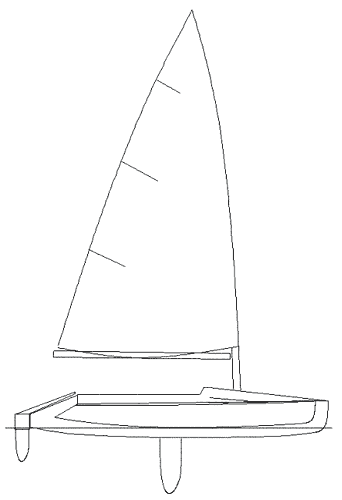
I actually spent more time thinking about the outriggers than about the main hull. In theory the outriggers will rarely be in the water. When they are though, I want the minimum wave making (more important at speed than wetted surface) and I didn't want to have the "windward outrigger slam" that is common to round bilge outriggers when sailing in a cross sea. I also wanted to have plenty of reserve buoyancy for the times when I do get caught out offwind. See below
And the ability to sail off and on a beach without the daggerboard would be a bonus. So, maybe surprisingly, I decided that a rounded V Quattro 14 type hull was the way to go.
But even with big outriggers in those survival conditions you may still capsize. The Strike should be easy to right because the outriggers can be easily folded forwards which means the boat becomes much narrower and thus less stable upside down, so can then be righted like any conventional dinghy.
The Strike 15 is very easy to build with a stitch and glue hard chine hull and flat panel ply decks. Estimated build time ready to paint is 150 hours. I have tried to design it so that each stage can be broken down into 2 hour segments, making it ideal for an evening-after-work project
CLICK HERE for a study plan (in pdf format). A sheet from the building plans is included in the free sample plan pack
Plans cost GBP105 and are available only as download plans in pdf format
The photos below show the prototype Strike 15 being built in Canada. The main hull is now finished and the outriggers started. Photos will be updated regularly, so keep checking back!
Photo after 12 hours of work - below
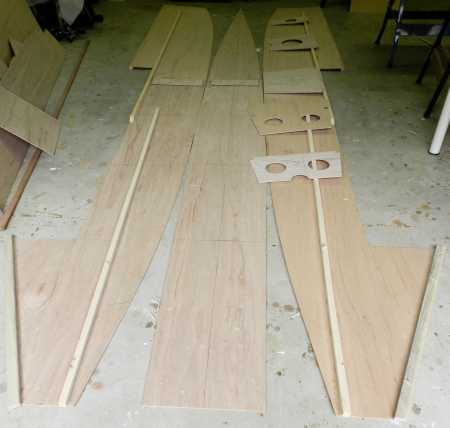
The bulkheads have been cut out and notched. The panels have been butt strapped together and all panel stiffening added. Almost ready to stitch together!
And then a few hours later the daggerboard box/king post assembly is made and glued in position
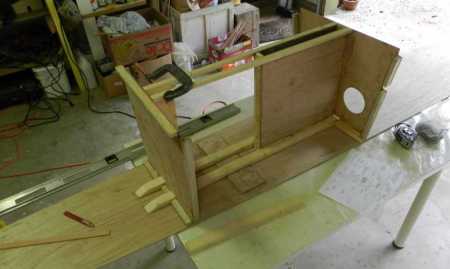
A bit more fiddling around, making a total of 25 hours work and the hull was ready to assemble. You can see me doing a dry fit below. Note it is all one camera shot, proving it really is an easy boat to put together. And unlike my other videos, this one does have sound. At this stage the boat weighs 16kgs
Surprisingly, it will also be possible to row a Strike 15. The outriggers are folded forward and the rower sits slightly aft, basically on the daggerboard box so he doesn't hit the mast. And you need oars about 3m (10ft) long. Obviously it would be much easier with two rowing, each sitting on the trampolines.

Our boatbuilder Cameron ("rowing" above) has carried on building the prototype. After 100 total build hours the main hull was complete.
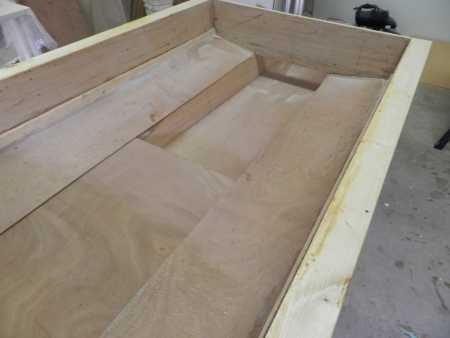
Almost finished cockpit. Looking aft (above) forward (below) prior to glassing joints and cutting out daggerboard box.
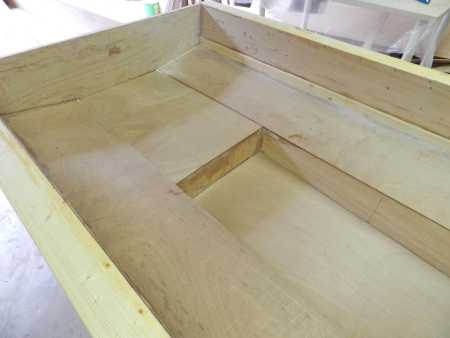
Jetti and Cameron lifting the complete unpainted hull to show its light weight
.jpg)
After a 6 month hiatus when we were out of the country work restarted on the prototype in May 2013. The photo below shows an outrigger ready to deck. Jetti could just lift it with one finger
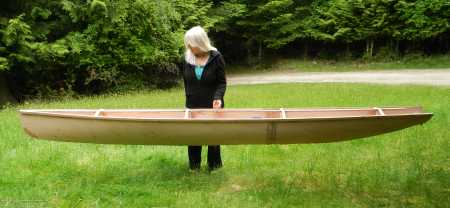
The cross beams are simple wood trusses. These are strong and light, but more important is that there is a big "hole" at the hull end so water won't slam against the beam. The outer ends are set well above the outrigger deck, again to reduce wave drag.
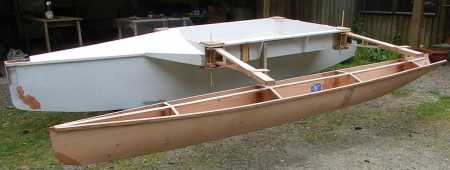
The outriggers fold forwards for transport, trailering beam is around 2.2m, 7ft. The video below shows how the system works (the boat is at a slight angle, so gravity is opening the boat out, normally it takes a gently push with one finger). The stays attach to the main hull so the outriggers can be folded in with the mast left up for storage in a dinghy park.
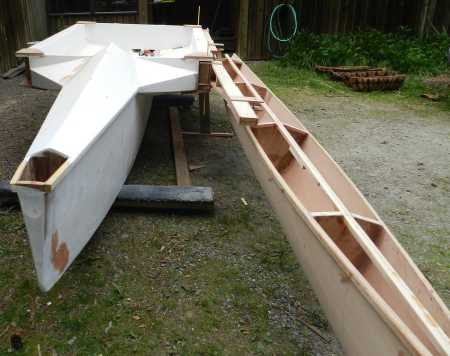
This photo was taken July 19th and shows the boat nearly finished
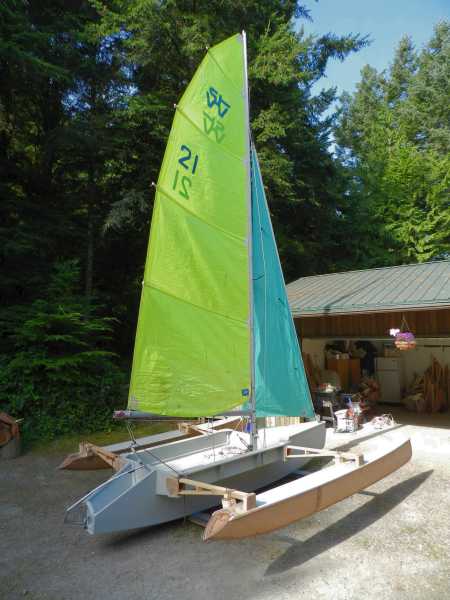
and this one, below, on its first sail, Aug 9th 2013, but still unfinished I'm afraid. Temporary trampolines, no paint on the beams, only primer paint on the hulls - it will eventually be purple, and a 15 year old mainsail. But it sailed just like a performance dinghy, tacking quickly and accelerating fast. Very manoeuverable. So exactly the "geriatric dinghy" concept I was hoping for
After sailing around in light winds for an hour I sailed it back straight onto the trailer (a shame Jetti didn't video it) at 6.05pm. At 6.30 we drove away, slowed considerably by arguing over how best to lash the boat down, it being our first time. Clearly it will get much quicker once we have the trailer sorted. But definitely an easy boat to rig and launch singlehanded
On my second sail we got the time down to 18 minutes, which included me changing into shore clothes. I still need to make a proper bracket to hold the mast on the trailer, and the real trampolines. So 15 minutes is quite feasible. As a comparison, I never managed to rig and launch a Laser dinghy in less than 10 minutes.
The main hull with fittings weighs about 60kgs, the outriggers 12kg each, the crossbeam 2.5kgs each. So all up weight is under the 130kg I predicted
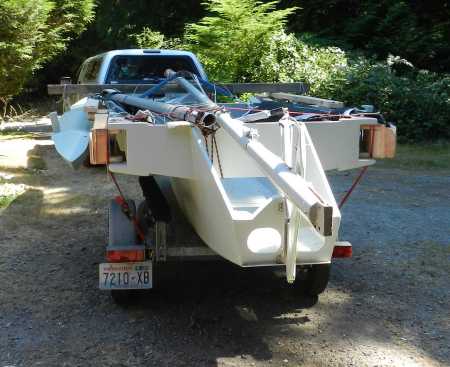
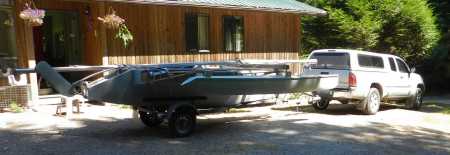
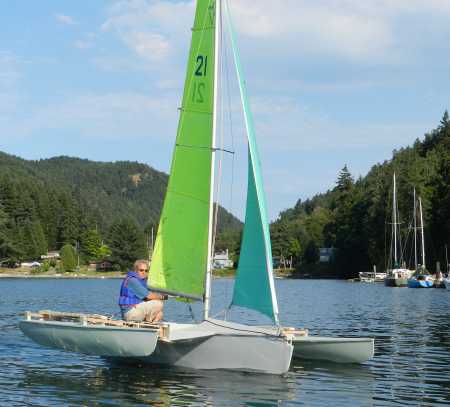
And the best photo so far taken by Marlene Mackenzie of the BCMS, close reaching at about 8 knots
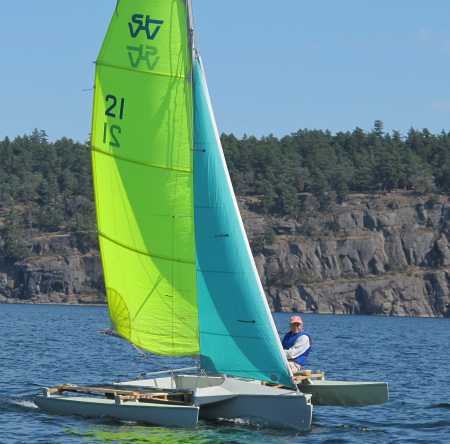
Strike 15 Approximate Materials List
6mm gaboon (okoume) marine ply (8ft x 4ft sheets) 1sheet
4mm gaboon (okoume) marine ply (8ft x 4ft sheets) 5 sheets
3mm gaboon (okoume) ply (8ft x 4ft sheets) 3 sheets
2in x 1in 20m
11/2in x 1in 5m
1in x 1in 20m
4in x 1in 5m
3in x 1in 3m
Epoxy resin 7kgs min 200g glass cloth 1kg min
Screws 3/4in #6 counter sunk stainless steel 500
Filler etc as required
Scrap timber for frame
No allowance for waste. Timber sizes nominal planed all round (PAR) use softwood, eg Douglas fir, Sitka spruce etc







